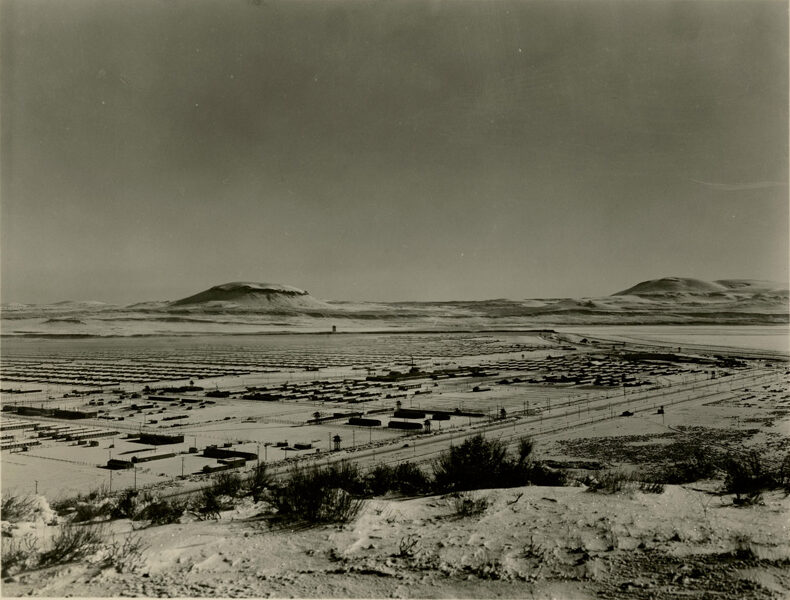California Stories

English Label
Newlin
Overview of Tule Lake Camp, c. 1943
Gelatin silver print
Following the bombing of Pearl Harbor at the outset of the U.S. involvement in WWII, the War Relocation Authority (WRA) was responsible for implementing the “relocation” of people of Japanese heritage on the West Coast. Ten camps, in reality prisons, were built throughout the United States. Prisoners sent to the high security Tule Lake camp were those seen by the U.S. government, often wrongly, as being anti-American.
In the winter of 1943, the WRA began administering a questionnaire that included two questions meant to determine who was loyal or disloyal to the United States. The questions asked if the individual would fight for the United States (the country that was imprisoning them), and if they would “forswear any form of allegiance or obedience to the Japanese emperor.” While most still respected and loved the Japanese emperor, they also wanted to demonstrate their loyalty to the United States, and they answered “yes” to the two questions. However, others objected to the questions. They either refused to answer, or they answered “no” to one or both questions. They were subsequently referred to as the No-No Boys, and they were segregated to the high security camp at Tule Lake. At the time, within the Japanese American community, there was considerable stigma attached to being a No-No Boy. Many today see their actions as a form of justified and courageous protest.
Most Japanese American men who were the appropriate age to be prospective soldiers were classified 4-C, enemy aliens, and were deemed unworthy to serve in the United States Military. Finally, the Roosevelt Administration determined that these men should be allowed to enter combat. In March of 1943, the 442 Regimental Combat Team was formed entirely of Japanese American soldiers. “Eventually, the 442nd, bolstered by the combat-hardened 100th Infantry Battalion, comprised of Japanese American draftees from Hawai’i, became the most decorated unit in U.S. military history for its size and length of service.” – Densho Encyclopedia
Spanish Label
Newlin
Overview of Tule Lake Camp [Panorama del Campo Tule Lake], c. 1943
Impreso en gelatina de plata
Después del bombardeo de Pearl Harbor al inicio de la intervención de los Estados Unidos en la Segunda Guerra Mundial, la War Relocation Authority (WRA) [Autoridad de reubicación de la guerra] era responsable por implementar la “reubicación” de las personas de herencia japonesa en la Costa Oeste. Se construyeron diez campos, en realidad prisiones, a través de los Estados Unidos. Los prisioneros enviados al campo de alta seguridad de Tule Lake eran aquellos considerados anti estadounidense por el gobierno de los Estados Unidos, a menudo erróneamente.
En el invierno de 1943, la WRA comenzó a administrar un cuestionario que incluía dos preguntas con la intención de determinar quien era leal o desleal a los Estados Unidos. Las preguntas eran si el individuo pelearía por los Estados Unidos (el país que los estaba encarcelando) y si “abjurarían cualquier forma de lealtad al emperador japonés”. Mientras que la mayoría aún respetaba y amaba al emperador japonés, también querían demostrar su lealtad a los Estados Unidos y contestaban “sí” a las dos preguntas. Sin embargo, otros objetaban las preguntas. O se reusaban a contestar o contestaban “no” a una o las dos preguntas. Debido a esto, se les llamaba los No-No Boys [Chicos No-No], y eran segregados en un campo de alta seguridad en Tule Lake. Durante esa época había mucho estigma asociado con ser un No-No Boy dentro de la comunidad japonesa estadounidense. Hoy, muchos ven sus acciones como una forma de justa y valiente protesta.
La mayoría de los hombres japoneses estadounidenses que estaban en la edad apropiada de ser potenciales soldados fueron clasificados 4-C, enemigos extranjeros, y fueron considerados indignos de servir en el Ejército de los Estados Unidos. Finalmente, la administración de Roosevelt determinó que se les debería permitir a estos hombres entrar en combate. En marzo de 1943, se formó el 442 Regimental Combat Team [Equipo del Regimiento de Combate] enteramente con soldados japoneses estadounidenses. “Eventualmente, el 442nd, reforzado por el 100th Batallón de infantería ya endurecido por el combate, compuesto de reclutas japoneses estadounidenses de Hawaii, se convirtió en la unidad más decorada en la historia militar de los Estados Unidos por el tamaño y duración de servicio”. – Densho Encyclopedia

